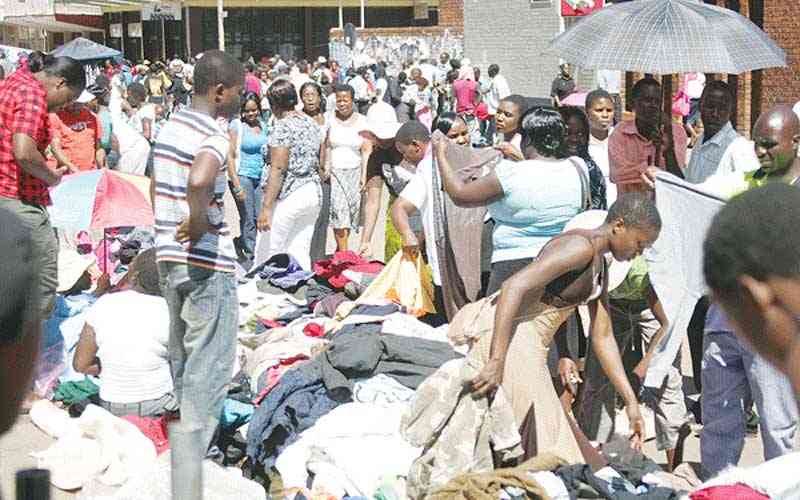
THE last two or so decades have seen a massive growth in the second-hand clothing business in Zimbabwe, an enterprise that has grown so big that it is now dubbed the ‘mabhero’ market.
In English, mabhero means ‘bales of clothes’ and the name was coined by traders who imported discarded clothes from the international market, which arrive in large containers.
The clothes are sold on street pavements and markets in Zimbabwe’s urban areas and business centres.
Once the clothes arrive, traders heap the clothes and start selling them allowing consumers to take their pick at anything they want.
It has become such a big industry that it is now sustaining many livelihoods as most of the income is in hard currency.
The Reserve Bank of Zimbabwe’s 2022 Finscope Consumer Survey Report, noted that an average adult earned US$100 while the average household income was US$370 a month.
The survey found that among the major monthly consumer costs, 84% used cash to buy clothes and footwear, pointing to a reliance on the mabhero business.
This is because at those wages, an adult and family would be restricted in what they could buy in terms of clothing.
- Putin exacerbates Africa’s food crisis
- Diamond Berry holds Winter Affair
- Internet gags costing Africa US$2bn in revenue
- State of a Zim worker lamentable
Keep Reading
On any day, it has become difficult to navigate through the streets of Harare as the second-hand clothes vendors have taken over pavements.
One such place is along Park Street, between Nelson Mandela and Jason Moyo Avenues in the central business district which has become a popular outdoor clothing mall.
Several stalls are placed almost ‘shoulder to shoulder’ while others have strewn clothes on the pavement in what has become a high traffic zone.
One cannot pass this area, on their way to the Copacabana bus terminus at the intersection of Speke Avenue and Chinhoyi Street, a few blocks away, without being accosted by a trader on Park Street.
But, the emergence of Covid-19 saw people becoming skeptical of buying these clothes paving way for a new wave of second hand clothing sales through use of ‘runners’ who are smuggling bales from Mozambique.
These have been providing an avenue for every street vendors to have an opportunity to sale ‘new clothes’ as they are obtained at unreasonably low prices.
This has also seen the emergence of car boutiques and pavement clothing dealers.
To catch up, most second-hand clothes sellers now have gone a step further to steam or iron these clothes and hang them on the mobile clothing lines.
While for many it has come as a blessing in disguise, market watchers have questioned the sustainability of the formal clothing business in Zimbabwe.
Big retail shops are feeling the heat and this has forced them to employ several strategies such as reducing their branch network and removing credit terms to stay afloat.
“And most worryingly now, you should look at the levels of unemployment and the level of incomes in this country.
“Informalisation coming from an individual’s point of view is a way of survival because of high unemployment levels and inadequate incomes.
“If it’s going to be only level playing field, it’s fine,” Truworths chief executive officer Bekithemba Ndebele told Standardbusiness.
“What you see is smuggling, not just smuggling but dumping of second-hand clothing at ridiculous prices.
“So, when we actually talk about dumping, we are actually talking about goods being sold in this market at below the cost of manufacturing.
“I will give you an example, you find a pair of shoes selling for US$2, 50.
“The minimum duty on a pair of shoes is US$2 per pair plus 40%. So how do you sell it for UD$2 or UD$2.50? It doesn’t make sense.”
He said that kids clothing, tracksuits, were being sold at US$5.
“The local manufacturer of tracksuits can’t produce a tracksuit for less than US$11.
“If he squeezes it and drops the fabric quality, it’s US$8.
“You see what I’m saying?
“So, this dumping of goods is a serious threat to former clothing retailers.”
Ndebele said Zimbabwe had become a dumping ground for poor quality products that are sold cheaply.
“But, if it’s outside Zimbabwe, it’s something else,” he said.
“That’s why they have got that capacity to then come and there is no way you can manufacture at that cost?.
“It’s either these are rejects from Chinese factories or exports that are undervalued.
“So, if it’s pure second-hand clothing, which is now in this country, we call it preloved.”
The Truworths boss said the future of Zimbabwe’s textile industry was bleak.
Zimbabwe first banned imports of second-hand clothes in 2015 in a bid to protect the country’s textile industry, but the regulations were later relaxed following an outcry by traders.
There is a new wave of smuggling of clothes especially by Chinese nationals.
Some major clothing retailers are relying are now even relying on the smugglers to restock.
Ndebele said African countries that have imposed the importation of second hand clothes had seen an improvement in their textile industries.
“Countries like Uganda and Rwanda are actually thriving (after banning second hand clothes trade),” he said.
“And the reasoning that is there is that they are saying we are moving into Africa, the African continental future.
“You have to make goods. You can’t be trading goods,” Ndebele asked.
“And in Rwanda’s view, it was how we can make goods when we allow goods to be dumped in our market.
“ In this country, the customs duties are clear on what should be done, the duties that should be applied.
“There is a ban on imported second-hand clothing, but it is still finding its way into the market.”
Ndebele noted that the country had lost over 90% of its textile manufacturers since 2015 with most of the shoe manufacturers also having left the country.
However, Edgars Stores Limited CEO Sevious Mushosho said they were not threatened by the emergence of car boutiques and pavement vendors.
“Our offering is targeted at customers who value exclusive high quality fashionable garments sold in a world class departmental store at flexible payment terms,” Mushosho said.
“Such customers may not buy from those car boutiques and from ‘mabhero’.”
Last month, Industry and Commerce minister Sithembiso Nyoni said government was reviewing the Zimbabwe Cotton to Clothing Strategy (2014-2019) in a bid to curb the influx of second-hand clothing which was choking the local textile industry.
“Over the years the clothing sector in Zimbabwe and Africa as a whole, has been faced by challenges of the influx of second-hand clothing, which has rendered the industry uncompetitive,” Nyoni said.
“To address this negative trend, the Ministry of Industry and Commerce is currently working on the review of the Zimbabwe Cotton to Clothing Strategy (2014-2019).
“This industry provides employment opportunities to millions of people worldwide, from designers and artisans to retail workers and logistic experts.
“Furthermore, the fashion industry has a strong influence on the global supply chain, as it relies heavily on international trade and the sourcing of raw materials.”










